|
|
|
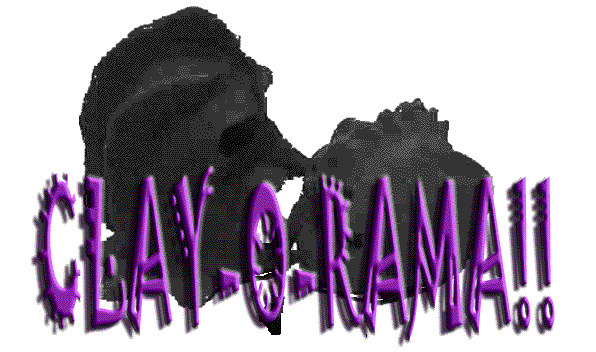
B/CS Intangible's Home Rules
What is Clay-O-Rama?
A Clay-O-Rama is many things. It is a chance for friends to meet and have a good time. It can be a serious philosophical discussion on the meaning of modeling clay. It is a means of artistic expression. It is a ritualistic
gathering of Claydonians to watch the violent destruction of others of their species. But, most of all, it is a silly game involving modeling-clay miniatures.
What do I need to have a Clay-O-Rama?
First, you need a group of people willing to be silly and have fun playing with modeling clay. Next, you need these rules or something like them. Then you need pencils, paper, and numerous six-sided dice for each player (a good number is four per player). Utterly unscientific testing has shown that PLAY-DOH Modeling Compound (BLATANT PLUG!) is well suited for use in a Clay-O-Rama. It is easily shaped, (it's cheap,) comes packaged in the proper amounts, (only $.50 a can,) and has pleasing, brilliant colors.


How do I create a Claydonian?
After you have assembled the items listed above, find a large , smooth space on which to play (uncarpeted, basement floors are the best). This could be several tables pushed together, or a smooth, tile floor. Do not play in a place where you do not want to have bits of modeling clay about. After you have assembled your friends, give each one a can of modeling clay. Try to let each player have the color he or she wants. After giving out the clay, tell the players the following:
"You have twenty minutes in which to make a creature out of your modeling clay. You may create anything you want, so long as it does not collapse at the slightest touch. You may not trade clay with another player; use your own clay. Use only clay to make your Claydonian, picks and tools are for sculpting purposes only. You do not have to use all of your clay; any clay you do not use may be shaped into missiles of any size and shape you want. Feet are good, sturdy is good, missiles are good, mouths and arms are good. The Referee is good. When you have finished making your Claydonian, let me know, and I will assign you your stats."
After telling your players this, let them go to it. Do not tell them any more about what will happen except that it will be a miniatures game. Encourage creativity. As each player finishes his or her creation, you must assign the creation it's Stats and Powers.
There are six categories of powers that must be assigned to each Claydonian: movement, number of attacks, damage, hit points, special powers, and missile stats, If applicable. Each one requires that you make a judgement about the creation of the player. The following are guidelines for assigning the powers; you may alter them as you see fit.
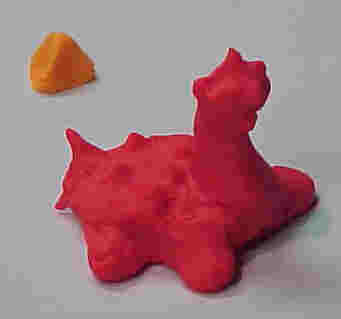
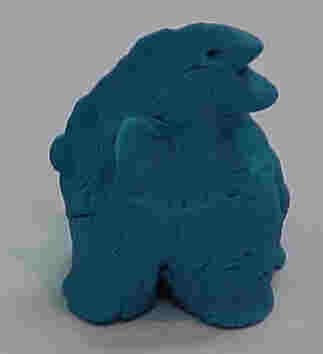
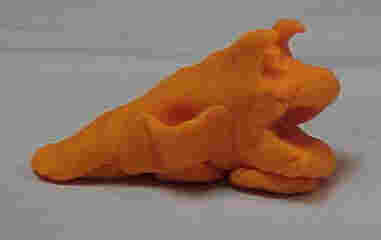
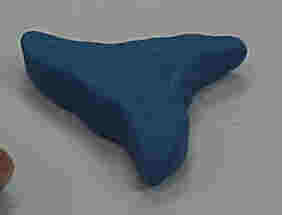
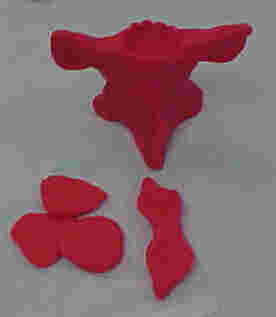
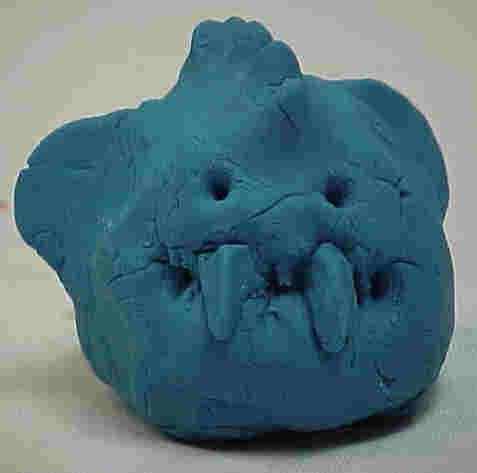
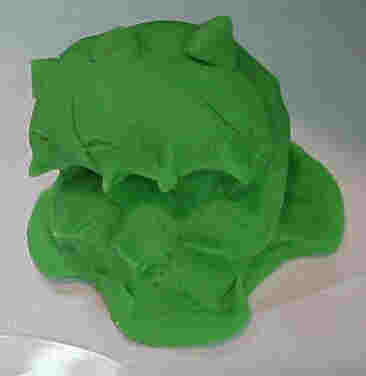
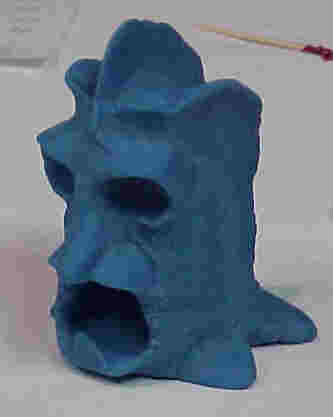
Judging Claydonian Stats:
Hit points: The base value of 1 can of PLAY-DOH is 50 HP. Look at the creature and compare it to the amount of clay kept aside to create missiles. If the entire can of clay was used to form the creature, it has 50 hit points. If half was used for missiles, the creature will have 25 hit points. Assign hit points based on the fraction of clay used to form missiles. If 25% of the clay is used for missiles, knock 25% off of 50 to find the creature's hit points. This is another judgement call on your part as the referee.

Movement: All movement is measured in spans of the player's outstretched hand from tip of thumb to tip of little finger) (see UNIFORMITY RULE later for people with small hands going against people with large hands.) The following table gives the basic movement rates.
NUMBER OF LEGS MOVEMENT
0 1 span
1-2 2 spans
3-4 3 spans
5 or more 4 spans
Note that a "leg" is any type of movement-producing appendage the claydonian
might have, even if it is a wheel. This appendage MUST be physically there, however, a player cannot simply declare it's existence. I.E. a jet engine must protrude slightly from the Claydonian, even drawing a circle and saying 'this is a jet engine' does not make it a movement producing appendage.
Number of Attacks: Look at the creation carefully. How many limbs can it use for attacking? This is the number of attacks it can make each turn. However, this number should never be more than four.
Damage: The base damage done in any attack is one six-sided die's worth of points. If the limbs are large, one or two more dice may be added to this. If the limbs are very large, three more dice may be added to this. If the attack is an absolute killer (say the Claydonian is just one, big, phallic-looking thing with one attack...), up to five dice may be added to the base attack die. As usual, you can decide all final attack values. If you're getting the idea that this is not a very exact game, you have the right idea. You're playing with clay monsters, right? Who needs to be exact?
Special Powers: Each creation gets one special power. It may be from the
list below, or it can be one you make up. If you make it up, it is recommended that you create a power that will affect modeling clay in some harmless way. (That means NO MICROWAVING!!!!!) The following powers may be assigned randomly by rolling a 30 sided die, or 2 die (1d3, 1d10) or may be chosen by you to match the creature in some way. The "to hit" number for all powers that require one is 8.
|
The Powers That Be!! (otherwise known as Special Powers) |
||
|
Roll w/ 1d30 or with 1d6 and 1d10 |
||
|
(1-2) |
(3-4) |
(5-6) |
|
1. The Drop |
11. Borrow Power |
21. Toss |
|
2. The Bowl |
12. Regenerate |
22. Catch |
|
3. The Poke |
13. Endurance |
23. Self As Missile |
|
4. Reshape One Limb |
14. Speed |
24. Trade |
|
5. The Blob of Death |
15. Stomp |
25. Paralyze |
|
6. Rip Limbs Off |
16. Absorb Missiles |
26. Glue |
|
7. Change Places |
17. Absorb Opponent |
27. Resist Power |
|
8. Move Out of Turn |
18. Drain Power |
28. Blindness |
|
9. Opponent as Missile |
19. Create Limb |
29. Teleport |
|
10. Levitate |
20. Repel |
30. Vampirism |
Judging Missile Stats: The base damage for a missile is one six-sided die for something about the size of a marble. Missiles smaller than this may do less damage. Missiles about the size of a Shooter marble do 2 six-sided dice damage, larger do three, and missiles up to golf ball size do five dice damage.
An entire can of PLAY-DOH, if used as a missile, would do 12 dice damage.
Play begins: Once all the players have created their Claydonians and have had powers assigned to them, have them gather around the playing area. Have the players space themselves at equal distances from each other. Each player should then roll three six-sided dice to finds his or her initiative number. Ties should be rolled off. Be sure each player notes his initiative number. After this is done, explain the What Do I Do, How Do I Move, How Do I Shoot, How Do I Attack, and How Do I Win rules to the players. Once everyone understands what is going on, begin the game.
What Do I Do?
The Clay-O-Rama is played in turns. A player gets to move his creation once during each turn. At several points during a turn, a player may have the opportunity to attack.
The players actions, in order chosen by player, are:
1. Move your creation up to it's full movement. -Note- Cannot be split between other actions, all movement occurs same segment only.
2. Fire up to three missiles at targets of your choice.
3. Attack any enemy to which your Creature is adjacent. Then
4. The other player (or players) physically attacked, may counterattack against your creature. Can use their special power at referees discretion.
Each player follows this sequence on their turn, until the player is out of the game or the game is over.
How does my Claydonian move? To move your creation, use your hand to measure the distance the creature moves, starting from the front of the creature. If there is no discernable front, begin measuring in the direction the creature last moved. Measure your movement hand-span to hand-span, then move your creature. Adding your creatures body size in between hand-spans is never allowed. There is no terrain in the game (although you can add some if you like). Thus, except when turning, a creature will always be able to move up to its full movement. If a part of the creation comes off during movement, the Claydonian loses hit-points based on the severity of the injury. The standard damage is 10 hit-points due to loss of limb.


How does my Claydonian shoot?
At the end of movement, each player is allowed to shoot up to three of his missiles. After a missile is fired, if it leaves the playing field, it is removed from play. Otherwise, any player can pick up any missile landing within a hand-span of him, but only on his turn and in place of 1 missile attack. If a player starts the game without any missiles, he has only 1 missile attack per round, therefore If multiple missiles are next to him on the playing field, he may pick up only 1 per turn, and cannot throw them until a turn when he does not use his 1 missile attack to pick up a missile. If a player has no missiles, he can't fire any. To fire a missile, the player stands at his own position at the table. The player may not move to a different area of the battlefield; he must fire his missiles from the point where his creation began the game. After the player has his position, have the player throw his missile, attempting to hit the target. Make it clear to the thrower that how hard the missile is thrown has NO effect on the amount of damage done. It is only the SIZE of the missile that matters.
It is a wise idea to have someone stand directly opposite the thrower to catch long shots and bounces. If the thrower manages to hit his target without having first hit the table, the missile has hit. If the missile missed, or rebounded, the shot is no good. If a missile hits a target, you must determine the amount of damage done by the missile. The Referee will determine your missile's damage values before the game begins.. All that's left is to roll-em!
How does my Claydonian attack?
Each Claydonian is assigned a number of attacks it can make in one turn, based upon the number of manipulative limbs or mouths it has. If a creation has used all its attacks, it may not make any more attacks for the rest of the turn. If your creation is adjacent to an enemy creation, you may decide to attack. "Adjacent" is defined as being within one hand-span of your creature. You may attack as many times as you have attacks.
You get a +1 "to hit" bonus to your regular attacks if your Claydonian is touching your target, and a +2 "to hit" bonus to your regular attacks if your Claydonian is on top of your target. If your target has spikes and other defensive devices, you may receive touching damage at Referee's discretion. Your target gets the same bonus on it's counterattack, and also any regular attacks on its turn if still in contact. No bonus is given to special powers attacks. To make an attack, you must announce your target and which attack is being used, (for special attacks, you may just let referee know it's being used, and what attack it's replacing.. you need not/should not name the power to your opponents) then roll two dice. If the dice roll is equal to or greater than your "to hit" number, you have hit your target with that attack.
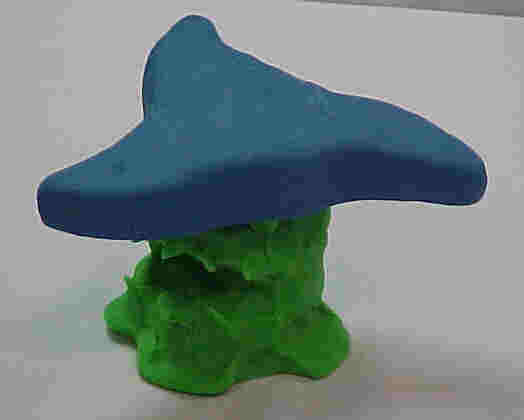
How does my Claydonian counterattack?
A Claydonian may counterattack if it is attacked by another creation during the combat phase. It may only make counterattacks against the creation that just attacked it. The counterattacks are handled as if they were normal attacks. A Claydonian may sometimes use its special power in a counterattack.
How do I win?
This depends on why you are playing in the first place. If you are playing to have fun, you win if you get really silly. If you are playing to be competitive and to beat out everyone else, you win if your creation is the last surviving Claydonian on the battlefield. Since only one person can win the second way, it's a lot nicer to play for the first reason.
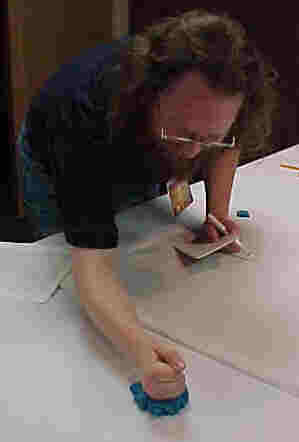
Honoring a Claydonian Death - What happens when my Claydonian dies?
Ah, this particular question has plagued the Claydonian philosophers for centuries. Several scurrilous theories have been presented, including the concepts of drying out or being eaten by small children and dogs. However in watching the deaths of several Claydonians on the field of battle, a common belief has arisen. Most Claydonians feel that when one of their kind dies, a large hand reaches from the heavens and squeezes the Claydonian through it's fingers. This act is always accompanied by a horrible scream that echoes through the heavens. Some Claydonians wish their bodies to be examples for future generations and insist on drying, creating a nice statue to use as a memorial, centerpiece, or clay pigeon.
Descriptions- The Powers That Be!! (A.K.A. Special Powers)
1. The Drop: Made in place of one normal attack. If a hit is successfully made, you then lift the target into the air and drop it 3'. Afterwards, the referee can decide the amount of damage based on what happened.
2. The Bowl: This power works like the drop, except you roll the target across the battlefield.
3. The Poke: Made in place off one normal attack. When a hit is made, you poke the target hard with your finger, making a nice hole in it. The referee decides the amount of damage.
4. Reshape One Limb: This power is used in place of a normal attack. If it hits successfully, the attacking player may alter the shape of any one limb of the target as he pleases. As referee, you should be ready to assign damage or altered powers because of this change.
5. The Blob of Death: This power may only be used by a creature with missiles. The player may designate one of the missiles to be his Blob of Death. It is fired like a normal missile (see "How does my Claydonian shoot?"). If it scores a hit, you should take your fist and give the target one solid smash to show the effects of the missile. After doing this, the referee must assign damage based on the consequences. Only one Blob of Death per game is allowed.
6. Rip Limbs Off: When the creature rolls an 11 or 12 on a normal attack, the player may tear one of his opponent's limbs off. Ah, that is, the player may tear off one of his Claydonian's opponent's limbs. Though this attack causes no damage to the target in terms of lost hit points, you should be ready to note any changes to the target's powers.
7. Change Places: After a successful power roll, creatures with this power may change places with any opponent on the board, or may change the places of any two other creatures on the board. The power user may not move in the same turn that it uses this power. This power must be used in the movement phase.
8. Move Out of Turn: Creatures with this power may move at any initiative point in the turn. They simply announce that they wish to move. They may not move in the middle of another player's movement phase. This is Movement only, no attacks, and in players turn they still receive their movement phase.
9. Use Opponent as Missile: If all of an attacker's limb's hit a target, he may pick his target up and use it as a missile against a third opponent. The missile is fired normally, and the referee should assess damage to both the missile and the target. If the missile misses the target, the missile takes damage from the drop as assessed by the referee.
10. Levitate: On a successful 'to hit' roll, Claydonian 'levitates' 2 hand-spans above the table for 1d6 turns. While levitated, Claydonian can only be hit by missile weapons and special powers that do not require physical contact by another Claydonian. (I.E. Use Opponent As Missile cannot affect him) While levitated, Claydonian cannot physically attack opponents and may only throw missile weapons, not pick them up. Movement while levitated is 1 hand-span.
11. Borrow Power: In addition to all normal attacks, a successful hit by this creature allows it to use the special power belonging to the target, if the attacker wants to do so. The decision must be made immediately or the borrowed power will be lost until another successful hit is made. The player with this power should not be told what the powers of other creatures are; he can only learn this by observation.
12. Regenerate: A Claydonian with this ability regenerates 1 six-sided die's worth of hit points at the start of each of it's turns. This ability allows the Claydonian to replace lost hit points only; it does not create new ones.
13. Endurance: The Claydonian with this power takes only half damage from all attacks. Round fractions down.
14. Speed: A Claydonian with this power can double it's movement in one turn in place of one attack. No tripling or quadrupling or so on your movement.
15. Stomp: This deadly attack may be used only once per gaming session. In addition, the Claydonian using this power is unable to take any action for two turns thereafter. The attacker chooses an opponent adjacent to him and rolls to hit. If a successful hit is made, the attacking player takes one of his shoes (or boots, if he is lucky enough) off and gives the opponent claydonian a good solid WHACK! with it. Damage should be determined by the amount of the
opponent flattened (e.g., if half of the Claydonian is flattened, it loses half of its hit points). Totally flattened Claydonians are left with only one hit point, unless they only had one to begin with. More than one Claydonian may be affected by this mode of attack, including the attacking Claydonian. If the attacker somehow misses, it still suffers the exhaustive effects of the blow. Smart players will wear mountain boots, moon boots, or track shoes for this attack Snow shoes or skis are not allowed.


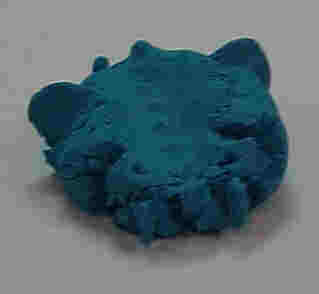
16. Missile Absorption: When hit by a missile, a Claydonian with this power rolls 2d6 and compares the result to its "to hit" number. If the result is over the "to hit" number, the claydonian takes no damage from the missile and may add the projectile to it's body mass. For each missile smaller than marble-size absorbed, add 1 hit point to the Claydonian. Add 2 hit points for each marble-size missile absorbed, 3 hit points for any missile up to golf ball size absorbed, and 4 hit points for anything over golf ball size. The missile is lost permanently and the absorbing Claydonian adds the new hit points to it's total (e.g., original total of target 50, and has been damaged to 35. Target successfully absorbs a marble-sized missile. New total 52 and has 37 left).This power does NOT allow a Claydonian to absorb the following: an opponent, a poke, a Blob of Death, or any object larger than fist size. In addition, absorbed missiles may not be used to create new missiles, they just add to the bulk of the Claydonian. IF the Claydonian rolls under it's
"to hit" roll, it takes half damage (round fractions down) from the missile and does not absorb it. Note that a Claydonian may not absorb missiles that it throws at itself, and it takes full damage from a missile if it does so.
17. Absorb Opponent: This power gives a Claydonian the ability to absorb any other Claydonian it kills. When a Claydonian with this power kills an opponent, it makes a "to hit" roll. If successful, the Claydonian adds the dead opponent to it's body bulk, adding the number of total hit points that the old opponent had to it's own total. (e.g., The Absorber has 50 total, 30 current. It
absorbs it's opponent who has 45 total (because of a missile) and 0 current (it's dead, Jim). The Absorber now has 95 total, 30 current, until the next game). If unsuccessful, the dead Claydonian goes screaming up to the Great Hand in the Sky (see Honoring a Claydonian Death). The Claydonian may NOT absorb an opponent that he has killed with a missile, unless adjacent.
18. Drain Power: A Claydonian with this power may drain one power from another Claydonian for six turns. Using this power takes the place of three attacks. To drain a power, the player must choose an opponent adjacent to his own Claydonian and make a successful "to hit" roll. If unsuccessful, the power is wasted. This power may be used once every five turns.
19. Create Limb: A Claydonian with this power may create a temporary limb. This temporary limb may replace one normal attack to create a small- to normal-size limb; it may replace two normal attacks for a large-size limb; and (how could you guess?) it may replace three normal attacks for a very-large-size limb. This temporary limb lasts for four turns, and it hits and does damage according to it's size. So, if your Claydonian already has four limbs, it could have five normal attacks per turn by adding a temporary limb. The turn the limb was created is it's first turn, followed by 3 turns with 5 attacks, then the limb must be re-created.
20. Repel: This power may be used by a desperate Claydonian in place of all attacks. No "to hit" roll is needed, and the results are immediate. When this power is used, all opponents must move their maximum movement ranges away from the user for 1 turn. Moreover, the powers Teleport, Change Places, and Move Out of Turn cannot be used by opponents for one turn. In addition, the user may not be hit by missiles for one turn. This power may be used every third turn.
21. Toss: A Claydonian with the Toss ability may use this power in place of all attacks. The attacker chooses an adjacent Claydonian and rolls the "to hit" dice. If successful, the player picks up the opponent's Claydonian and tosses it no farther than the gaming area. If the opponent is tossed off or out of the gaming area, it may reshape itself, lose no hit points, and reappear in the gaming area anywhere it chooses. (except on another Claydonian). The number of hit points lost must be determined by the referee. This number depends on the amount of structural damage sustained (about 10-20 hit points is appropriate). Tossing an opponent at the ceiling is legal as
long as the opponent lands in the game area. If the opponent is tossed against the ceiling and hits the game surface, 20-30 hit points of damage are taken. If the opponent sticks to the ceiling, the Claydonian is out of the game until it falls. If it never falls and dries up instead, consider it dead.
22. Catch: When something is thrown at a Claydonian with this power, the Claydonian makes a "to hit" roll. If successful, the Claydonian catches the item thrown at it. If the item happens to be a missile, the Claydonian catching it can reuse the missile. If the thrown object is another Claydonian, the target Claydonian catches it and takes no damage. If the Claydonian is unsuccessful in its "to hit" roll, it takes full damage from the missile. A Claydonian with this power CANNOT catch a shoe, a poke, or anything other than a missile or another Claydonian.
23. Use Self As Missile: This power allows a player to throw his Claydonian in the same way one would throw a missile. The referee will assess the damage taken by both the missile and the target.
24. Trade: In a desperate situation, a Claydonian with this power can choose an opponent in an adjacent area and make a "to hit" roll. If successful, the player trades his Claydonian for the target Claydonian. This power may only be used once per game in place of all attacks for that turn. The player plays the new Claydonian with it's shape, hit points, attacks, and movement, but retains his former Claydonian's powers. Likewise, the other player retains his former Claydonian's powers but is stuck with your Claydonian's body.
25. Paralyze: On a successful "to hit" roll, a Claydonian can cause an adjacent opponent to stop moving and attacking for two rounds. This attack takes the place of all normal attacks. The paralyzed Claydonian cannot initiate any action for two rounds. This power may be used every three turns.
26. Glue: a Claydonian can cause multiple opponents to stop moving for 1-3 rounds. A separate 'to hit' roll must be made for each opponent. This attack takes the place of all physical attacks. Glued characters may still shoot missiles, or attack opponents that are adjacent to them. Teleport and levitate still function, even if glued.
27. Resist Power: When a power is successfully rolled that affects this creature in any way, the Claydonian can roll to resist the power. On a successful "to Hit" roll, the effects of the first power are negated on this creature only. For Instance, a successfully resisted 'repel' will still move every other creature away from caster, but resisting creature remains stationary. A player cannot resist powers that affect other creatures, however. I.E. Missile absorption, catch, endurance, and speed should NOT activate this power.
28. Blindness: On a successful 'to hit' roll, any one opponent may be blinded for 1-3 turns. Movement of blinded Claydonian, if initiated, goes in random directions. Character declares number of hand-spans desired, then moves in a direction determined by dice roll using 'teleport' table. If their movement would cross another claydonian, they stop there. To attack, a blinded Claydonian must roll a 5 or 6 on a 6-sider to verify they are attacking in the correct direction, in addition to the normal 'to hit' roll. To shoot missiles, player must close their eyes before throwing. This attack replaces all missile attacks for 1-3 turns, and may only be used once every 3 turns.
29. Teleport: A Claydonian can use this power in place of all it's missile attacks. The Claydonian with this ability can reappear anywhere on the game surface and, if possible, attack right away. To Teleport, the player must specify any vacant spot on the game surface that he wants his Claydonian to occupy. The player then rolls the "to hit" dice. If unsuccessful, the player must then roll 1d6 twice. The first roll determines which direction the Claydonian teleported:
Roll Direction
1 Stays in same place
2 North
3 West
4 South
5 East
6 Stays in same place
The second die roll determines how many spans that the Claydonian moves, if any.
30. Vampirism: On a successful physical attack, instead of just inflicting damage, vampire may make a power roll. If it's successful, 1-6 hit-points are drained from victim, and added to vampire's total. If a victim dies during a vampiric attack, victim becomes a vampire starting with 1-6 hit-points, and loses their original special power. The new vampire is dormant for one turn before being able to attack, and is immune to further vampiric attack.
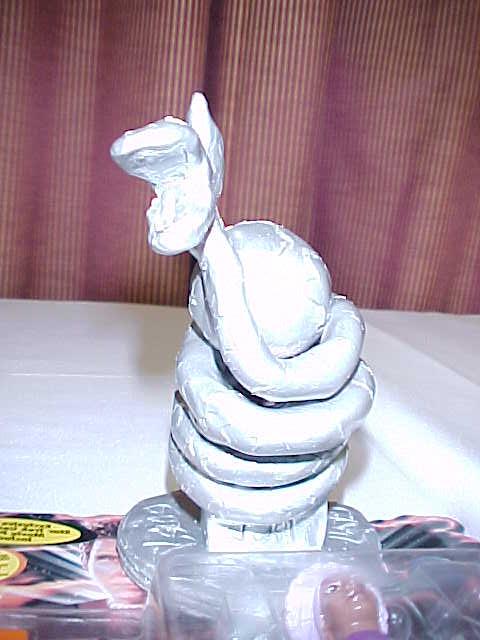
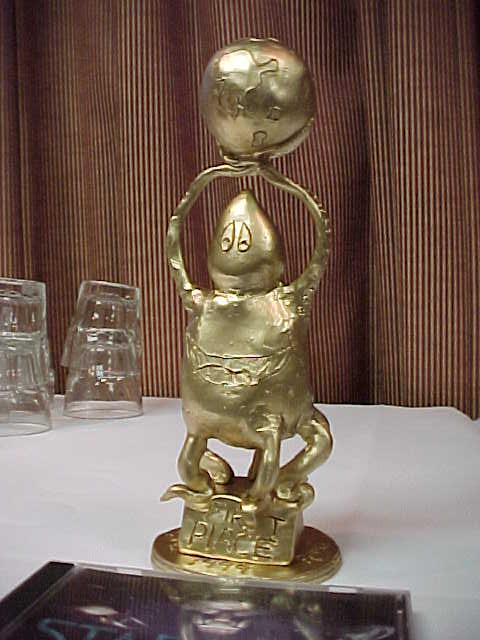
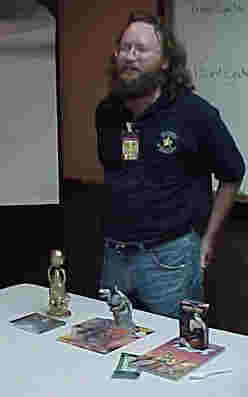
In Special matches, permanent clay Trophies (NOT Play-DOH) may be given out.
Optional Rules:
UNIFORMITY RULE: Note that if some people feel that the hand-span measuring system is unfair or grossly inaccurate, you may then enforce the Uniformity Rule. The Uniformity Rule states that all distances will be measured by the referee's hand. However, this will slow down play of the game and place a great deal of work in the hands of the referee (ahem).
CAMPAIGN RULES:
Some of you sick-o's out there may like this game enough to become infatuated with it and even cry when your claydonian dies. Well, start a campaign... You can have the Claydonian gain levels... here's how:
# Enemies
Destroyed Experience Total
or Defeated Level Title Benefits (Non-Cumulative)
-------------------------------------------------------------------------
0-5 1 Silly Thing 1 Power
6-15 2 Weirdo 2 Powers, + 5 hit points
16-30 3 Freak 3 Powers, +10 hit points
31-50 4 Kook 4 Powers, +20 hit points
51-80 5 Blob Monster 5 Powers, +30 hit points
81 6 Supreme Slime Claydonian dies of old age
Taking the same power twice: If a player opts to take the same power twice, the effects of the power are doubled.
I.E.: Regeneration gives 2-12hp a turn instead of 1-6 each turn. Absorb Opponent 2x cuts the "to hit" number needed by half.
If you decide on Campaign, here are some suggestions:
1) Make a hard-paper copy of your Claydonian... Draw it on a piece of paper and record statistics.
2) Become owner of a bunch of Claydonians (Store a lot of sheets, but just like role-playing game characters, do NOT use dead Claydonians.
3) Make money bets on the games. Illegal where prohibited.
WALLS RULE: When you play Clay-O-Rama, you usually do so on a table or floor.. that is all well and good, but here's something to spice it up... LIMIT SPACE.
On a floor, the borders could be made with masking tape (you use Play-Doh on the floor, so WHY NOT TAPE TOO?). On a table, the border is the table edge. After a set amount of turns (usually 4 or 5), the "Walls come down", meaning that any claydonian can escape the battle by running off the field of battle. This is only really useful in a campaign.
OBSTACLES: You use Play-DOH, right? Well, use the Play-DOH CANS for obstacles, Wooden blocks, and various other objects can be used also.
TAG TEAM: You have two monsters, OR an even number of players, (4, 6, 8), and each makes a monster. Forming teams of two, (or one for 2 player version), one player sits on the sidelines while the other goes in to fight. The waiting player may use any of his Claydonian's missiles on his turn, as initiative is established normally. The fighting claydonian may leave to it's corner at any time after battle has begun, and it's partner takes it's place at the end of the fighting Claydonian's turn. Game resumes. Regeneration makes this sort of play LAST LONG. A claydonian on the sidelines gains back HP at 1 per turn resting (regenerators still roll, NO BONUS!!!)
GM PLAYS: As a GM the game sometimes gets REALLY BORING... So... make your own Claydonian and have the other players judge what it's stats are, and then play along (assuming you are a FAIR GM...) ALSO:
ARENA OF DEATH: GM creates a monster and assigns it powers. (a big A$$-Kicker) Everyone has to gang up and kill it or they will ALL DIE. =) One of Zeb's favorites was when a GM played a "Caterpillar" on him made of green Play-DOH with orange feet. It had 4 sections, and could split apart and each had it's own power (It's 4, 4, 4 beasts in one, WoW!)
Whichever rules you choose.... Enjoy!
To contact the U.S.S. Intangible, Email ghostwriter@startrekmail.com

Credits-
Edited CLAY-O-RAMA (CLAYDONIA) RULES Adapted from Dragon Magazine #125 by David 'Zeb" Cook and #144 by Paul C. Easton)
Most recent adaptation (this one) by Cheryl Taylor, U.S.S. Intangible
Pictures taken by W. Causey, U.S.S. Intangible at a summit tournament
rule sheet this was adapted from was By, JDMARQUART@MIAVX1.ACS.MUOHIO.EDU
Adapted by Joshua "Cheese" Marquart